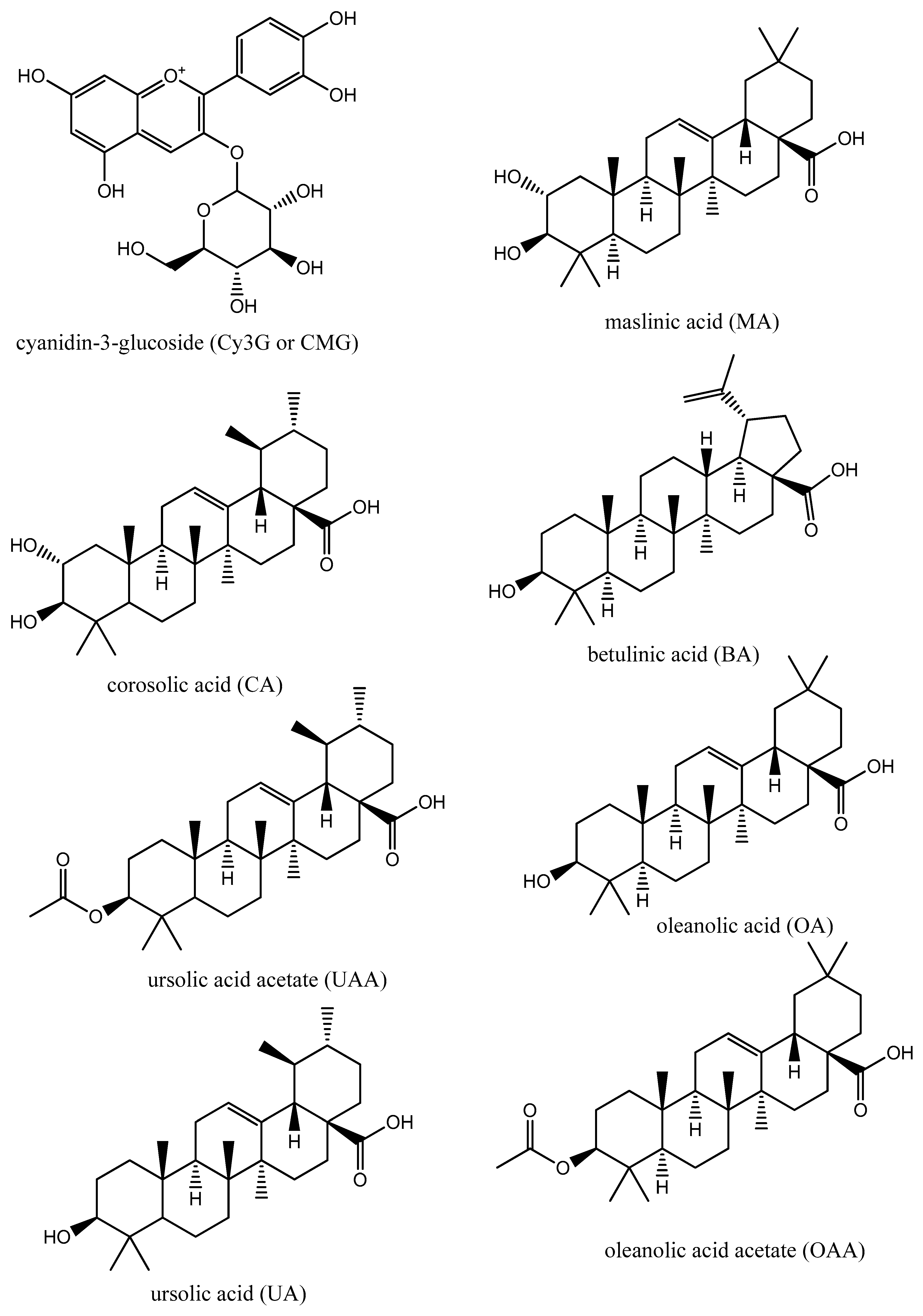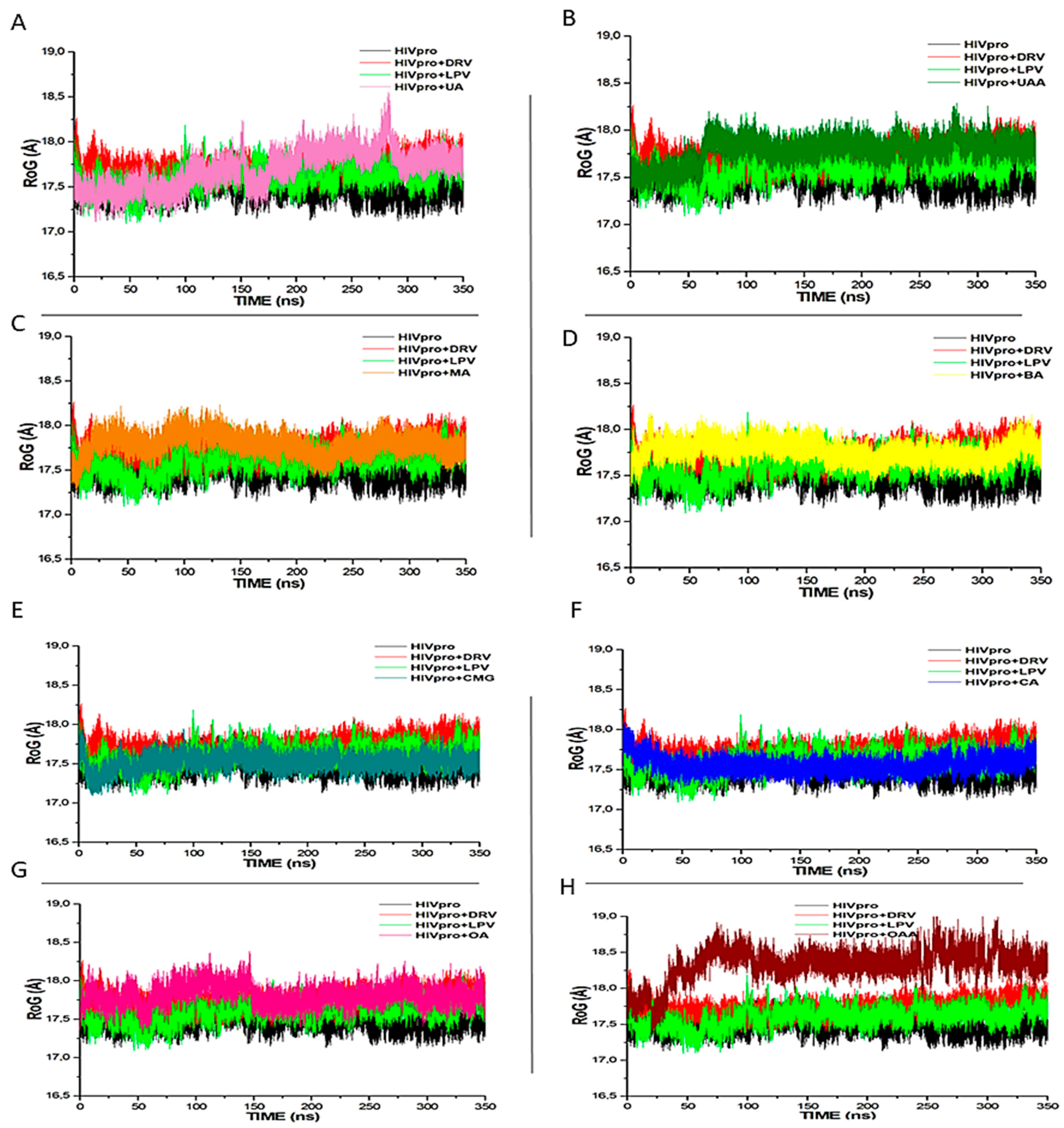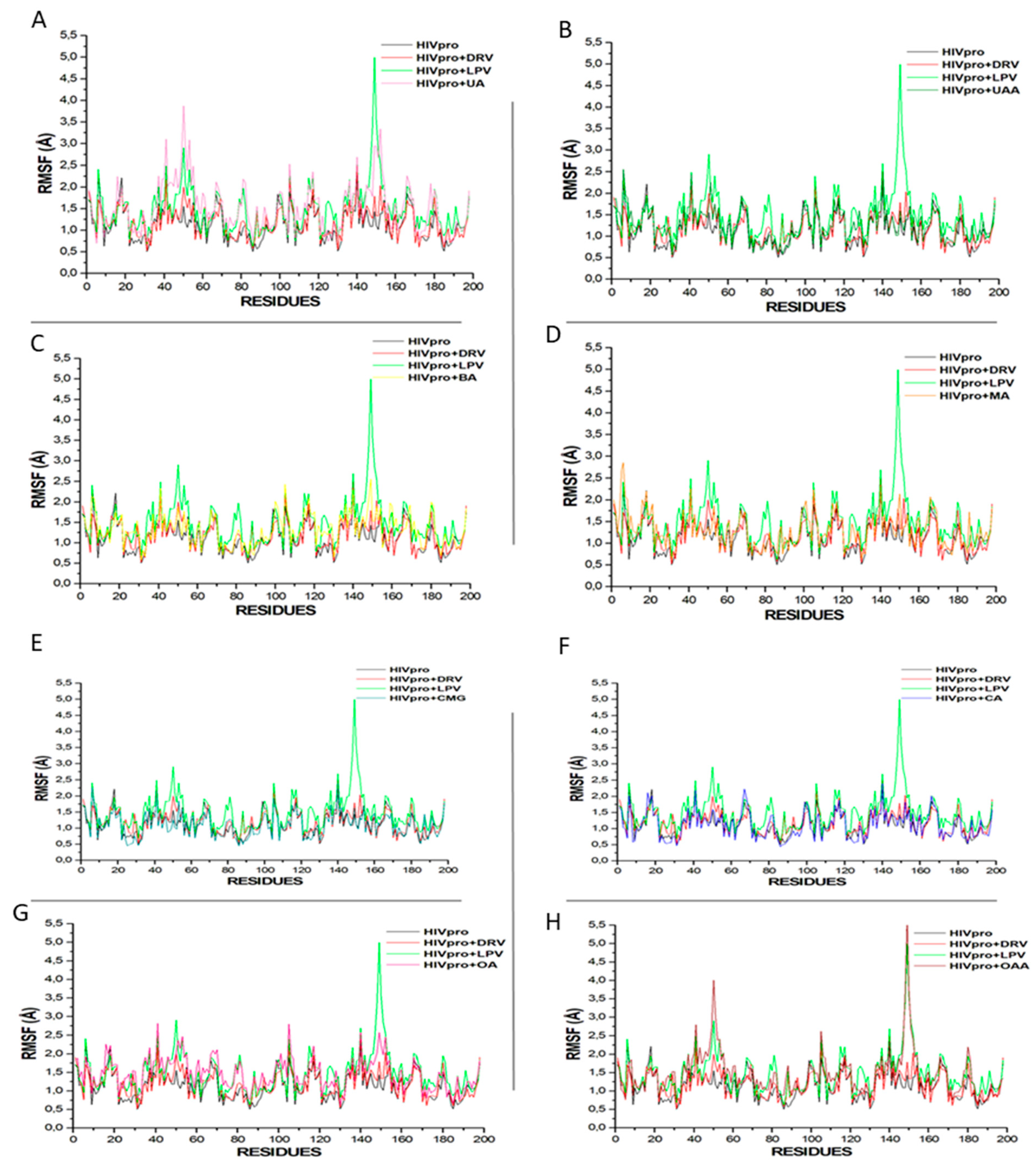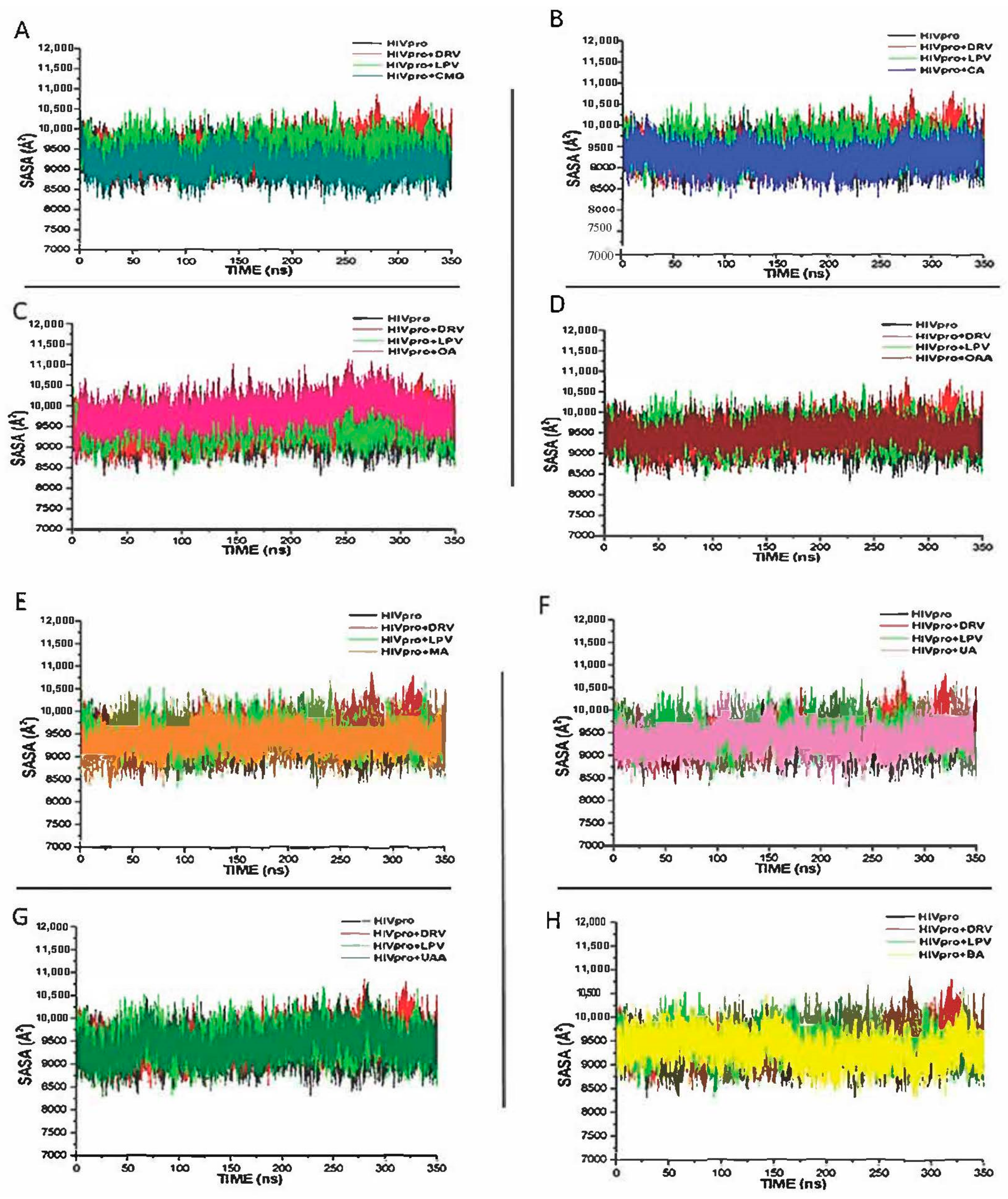Molecular Dynamics Study on Selected Bioactive Phytochemicals as Potential Inhibitors of HIV-1 Subtype C Protease
Abstract
:1. Introduction
2. Methods
2.1. HIV-1 Protease and Metabolite Acquisition and Preparation
2.2. Molecular Docking (MD)
2.3. Molecular Dynamics Simulation (MDS)
2.4. Post-Dynamic Analysis
2.5. Binding Free Energy Calculations and Data Analysis
3. Results and Discussion
3.1. Stability, Compactness, and Flexibility of HIV-1pro Apo and HIV-1pro Bound Systems
3.2. Solvent Accessible Surface Area (SASA)
3.3. HIVpro–Ligand Interaction
4. Conclusions
Author Contributions
Funding
Institutional Review Board Statement
Informed Consent Statement
Data Availability Statement
Acknowledgments
Conflicts of Interest
References
- Sepkowitz, K.A. AIDS—The first 20 years. N. Engl. J. Med. 2001, 344, 1764–1772. [Google Scholar] [CrossRef] [PubMed]
- WHO. HIV/AIDS. 2021. Available online: http://who.int/health-topics/hiv-aids#tab_1 (accessed on 24 July 2021).
- Arts, E.J.; Hazuda, D.J. HIV-1 Antiretroviral Drug Therapy. Cold Spring Harb. Perspect. Med. 2012, 2, a007161. [Google Scholar] [CrossRef] [PubMed] [Green Version]
- Brik, A.; Wong, C.-H. HIV-1 protease: Mechanism and drug discovery. Org. Biomol. Chem. 2003, 1, 5–14. [Google Scholar] [CrossRef] [PubMed]
- Nayak, C.; Chandra, I.; Singh, S.K. An in silico pharmacological approach toward the discovery of potent inhibitors to combat drug resistance HIV-1 protease variants. J. Cell. Biochem. 2019, 120, 9063–9081. [Google Scholar] [CrossRef] [PubMed]
- Levy, Y.; Caflisch, A. Flexibility of Monomeric and Dimeric HIV-1 Protease. J. Phys. Chem. B 2003, 107, 3068–3079. [Google Scholar] [CrossRef]
- Scholar, E. HIV Protease inhibitors. In XPharm: The Comprehensive Pharmacology Reference; Elsevier, Inc.: Philadelphia, PA, USA, 2011; pp. 1–4. [Google Scholar]
- Nix, A.; A Paull, C.; Colgrave, M. The flavonoid profile of pigeonpea, Cajanus cajan: A review. SpringerPlus 2015, 4, 1–6. [Google Scholar] [CrossRef] [Green Version]
- Lakshmi, V.J.; Manasa, K. Various Phytochemical Constituents and Their Potential Pharmacological Activities of Plants of the Genus Syzygium. Am. J. PharmTech Res. 2021, 11, 68–85. [Google Scholar] [CrossRef]
- Hou, W.; Zhang, W.; Chen, G.; Luo, Y. Optimization of extraction conditions for maximal phenolic, flavonoid, and antioxidant activity from Melaleuca bracteata leaves using response surface methodology. PLoS ONE 2016, 11, e0162139. [Google Scholar] [CrossRef] [Green Version]
- Mlala, S.; Oyedeji, A.O.; Gondwe, M.; Oyedeji, O.O. Ursolic acid and its derivatives. Molecules 2019, 24, 2751. [Google Scholar] [CrossRef] [Green Version]
- Afolabi, W.O.; Hussein, A.; Shode, F.O.; Le Roes-Hill, M.; Rautenbach, F. Leptospermum petersonii as a Potential Natural Food Preservative. Molecules 2020, 25, 5487. [Google Scholar] [CrossRef]
- Parra, A.; Rivas, F.; Lopez, P.E.; Garcia-Granados, A.; Martinez, A.; Albericio, F.; Marquez, N.; Muñoz, E. Solution- and solid-phase synthesis and anti-HIV activity of maslinic acid derivatives containing amino acids and peptides. Bioorg. Med. Chem. 2009, 17, 1139–1145. [Google Scholar] [CrossRef] [PubMed]
- Slimestad, R.; Solheim, H. Anthocyanins from black currants (Ribes nigrum L.). J. Agric. Food Chem. 2002, 50, 3228–3231. [Google Scholar] [CrossRef]
- Stohs, S.J.; Miller, H.; Kaats, G.R. A Review of the Efficacy and Safety of Banaba (Lagerstroemia speciosa L.) and Corosolic Acid. Phytother. Res. 2012, 26, 317–324. [Google Scholar] [CrossRef] [PubMed]
- Pavlova, N.; Savinova, O.; Nikolaeva, S.; Boreko, E.; Flekhter, O. Antiviral activity of betulin, betulinic and betulonic acids against some enveloped and non-enveloped viruses. Fitoterapia 2003, 74, 489–492. [Google Scholar] [CrossRef]
- Tohmé, M.; Giménez, M.; Peralta, A.; Colombo, M.; Delgui, L. Ursolic acid: A novel antiviral compound inhibiting rotavirus infection in vitro. Int. J. Antimicrob. Agents 2019, 54, 601–609. [Google Scholar] [CrossRef]
- Khwaza, V.; Oyedeji, O.O.; Aderibigbe, B.A. Antiviral Activities of Oleanolic Acid and Its Analogues. Molecules 2018, 23, 2300. [Google Scholar] [CrossRef] [Green Version]
- Jiménez-Arellanes, A.; Meckes, M.; Torres, J.; Luna-Herrera, J. Antimycobacterial triterpenoids from Lantana hispida (Verbenaceae). J. Ethnopharmacol. 2007, 111, 202–205. [Google Scholar] [CrossRef]
- Kim, M.J.; Kim, C.S.; Park, J.Y.; Lim, Y.K.; Park, S.N.; Ahn, S.J.; Jin, D.C.; Kim, T.H.; Kook, J.K. Antimicrobial effects of ursolic acid against mutans Streptococci isolated from Koreans. Int. J. Oral Sci. 2011, 36, 7–11. [Google Scholar]
- Olivas-Aguirre, F.J.; Rodrigo-García, J.; Martínez-Ruiz, N.D.R.; Cárdenas-Robles, A.I.; Mendoza-Díaz, S.O.; Álvarez-Parrilla, E.; González-Aguilar, G.A.; De la Rosa, L.A.; Ramos-Jiménez, A.; Wall-Medrano, A. Cyanidin-3-O-glucoside: Physical-Chemistry, Foodomics and Health Effects. Molecules 2016, 21, 1264. [Google Scholar] [CrossRef] [Green Version]
- Qian, X.-P.; Zhang, X.-H.; Sun, L.-N.; Xing, W.-F.; Wang, Y.; Sun, S.-Y.; Ma, M.-Y.; Cheng, Z.-P.; Wu, Z.-D.; Xing, C.; et al. Corosolic acid and its structural analogs: A systematic review of their biological activities and underlying mechanism of action. Phytomedicine 2021, 91, 153696. [Google Scholar] [CrossRef]
- Lin, X.; Ozbey, U.; Sabitaliyevich, U.Y.; Attar, R.; Ozcelik, B.; Zhang, Y.; Guo, M.; Liu, M.; Alhewairini, S.S.; Farooqi, A.A. Maslinic acid as an effective anticancer agent. Cell. Mol. Biol. 2018, 64, 87–91. [Google Scholar] [CrossRef]
- Burley, S.K.; Berman, H.M.; Christie, C.; Duarte, J.M.; Feng, Z.; Westbrook, J.; Young, J.; Zardecki, C. RCSB Protein Data Bank: Sustaining a living digital data resource that enables breakthroughs in scientific research and biomedical education. Protein Sci. 2018, 27, 316–330. [Google Scholar] [CrossRef] [PubMed] [Green Version]
- Yang, Z.; Lasker, K.; Schneidman-Duhovny, D.; Webb, B.; Huang, C.C.; Pettersen, E.F.; Goddard, T.D.; Meng, E.C.; Sali, A.; Ferrin, T.E. UCSF Chimera, MODELLER, and IMP: An integrated modeling system. J. Struct. Biol. 2012, 179, 269–278. [Google Scholar] [CrossRef] [PubMed] [Green Version]
- Kim, S.; Thiessen, P.A.; Bolton, E.E.; Chen, J.; Fu, G.; Gindulyte, A.; Han, L.; He, J.; He, S.; Shoemaker, B.A.; et al. PubChem substance and compound databases. Nucleic Acids Res. 2016, 44, D1202–D1213. [Google Scholar] [CrossRef]
- Hanwell, M.D.; Curtis, D.E.; Lonie, D.C.; Vandermeerschd, T.; Zurek, E.; Hutchison, G.R. Avogadro: An advanced semantic chemical editor, visualization, and analysis platform. J. Cheminform. 2012, 4, 17. [Google Scholar] [CrossRef] [Green Version]
- Grosdidier, A.; Zoete, V.; Michielin, O. SwissDock, a protein-small molecule docking web service based on EADock DSS. Nucleic Acids Res. 2011, 39, W270–W277. [Google Scholar] [CrossRef] [Green Version]
- Nair, P.C.; O Miners, J. Molecular dynamics simulations: From structure function relationships to drug discovery. Silico Pharmacol. 2014, 2, 4. [Google Scholar] [CrossRef] [PubMed] [Green Version]
- Le Grand, S.; Götz, A.W.; Walker, R.C. SPFP: Speed without compromise—A mixed precision model for GPU accelerated molecular dynamics simulations—ScienceDirect. Comput. Phys. Commun. 2013, 184, 374–380. [Google Scholar] [CrossRef]
- Ylilauri, M.; Pentikainen, O.T. MMGBSA as a tool to understand the binding affinities of filamin-peptide interactions. J. Chem. Inf. Model. 2013, 53, 2626–2633. [Google Scholar] [CrossRef] [PubMed]
- Seifert, E. OriginPro 9.1: Scientific data analysis and graphing software-software review. J. Chem. Inf. Model. 2014, 54, 1552. [Google Scholar] [CrossRef]
- Sabiu, S.; Idowu, K. An insight on the nature of biochemical interactions between glycyrrhizin, myricetin and CYP3A4 isoform. J. Food Biochem. 2021, 46, e13831. [Google Scholar] [CrossRef] [PubMed]
- Kehinde, I.; Ramharack, P.; Nlooto, M.; Gordon, M. The pharmacokinetic properties of HIV-1 protease inhibitors: A computational perspective on herbal phytochemicals. Heliyon 2019, 5, e02565. [Google Scholar] [CrossRef] [Green Version]
- Hayashi, H.; Takamune, N.; Nirasawa, T.; Aoki, M.; Morishita, Y.; Das, D.; Koh, Y.; Ghosh, A.K.; Misumi, S.; Mitsuya, H. Dimerization of HIV-1 protease occurs through two steps relating to the mechanism of protease dimerization inhibition by darunavir. Proc. Natl. Acad. Sci. USA 2014, 111, 12234–12239. [Google Scholar] [CrossRef] [Green Version]
- Shumungam, L.; Soliman, M. Targeting HCV polymerase: A structural and dynamic perspective into the mechanism of selective civalent inhibition. RSC Adv. 2018, 8, 42210–42222. [Google Scholar] [CrossRef] [PubMed] [Green Version]
- Aribisala, J.O.; Nkosi, S.; Idowu, K.; Nurain, I.O.; Makolomakwa, G.M.; Shode, F.O.; Sabiu, S. Astaxanthin-Mediated Bacterial Lethality: Evidence from Oxidative Stress Contribution and Molecular Dynamics Simulation. Oxidat. Med. Cell. Longev. 2021, 2021, 7159652. [Google Scholar] [CrossRef] [PubMed]
- Hess, B. Convergence of sampling in protein simulations. Phys. Rev. E 2002, 65, 031910. [Google Scholar] [CrossRef] [PubMed] [Green Version]
- Obakachi, V.A.; Kushwaha, N.D.; Kushwaha, B.; Mahlalela, M.C.; Shinde, S.R.; Kehinde, I.; Karpoormath, R. Design and synthesis of pyrazolone-based compounds as potent blockers of SARS-CoV-2 viral entry into the host cells. J. Mol. Struct. 2021, 1241, 130665. [Google Scholar] [CrossRef] [PubMed]
- Uhomoibhi, J.O.-O.; Shode, F.O.; Idowu, K.A.; Sabiu, S. Molecular modelling identification of phytocompounds from selected African botanicals as promising therapeutics against druggable human host cell targets of SARS-CoV-2. J. Mol. Graph. Model. 2022, 114, 108185. [Google Scholar] [CrossRef]






| Compound Name | Docking Score (kcal/mol) |
|---|---|
| FDA-Approved Drugs | |
| LPV | −8.4 |
| DRV | −8.1 |
| Selected Bioactive Phytochemicals | |
| CMG | −9.9 |
| MA | −9.3 |
| CA | −9.0 |
| BA | −8.3 |
| OA | −8.6 |
| OAA | −8.2 |
| UAA | −8.5 |
| UA | −8.1 |
| Complex | ΔEvdw | ΔEelec | ΔGgas | ΔGsolv | ΔGbind |
|---|---|---|---|---|---|
| FDA-Approved Drugs | |||||
| LPV | −51.973 ± 5.433 | −27.534 ± 6.605 | −79.507 ± 7.958 | −38.291 ± 3.540 | −44.571 ± 3.952 |
| DRV | −45.805 ± 6.108 | −28.424 ± 8.120 | −69.223 ± 10.871 | −29.235 ± 4.206 | −40.311 ± 4.943 |
| Selected Bioactive Phytochemicals | |||||
| CMG | −37.080 ± 5.298 | −41.112 ± 7.929 | −78.176 ± 9.411 | −20.285 ± 4.879 | −57.890 ± 6.693 |
| MA | −47.442 ± 4.300 | −28.057 ± 6.689 | −73.166 ± 9.794 | −25.032 ± 4.845 | −48.134 ± 6.002 |
| CA | −45.738 ± 2.979 | −19.633 ± 6.132 | −67.884 ± 5.446 | −23.306 ± 3.976 | −43.900 ± 4.101 |
| BA | −45.850 ± 4.123 | −44.778 ± 9.576 | −71.628 ± 8.503 | −10.954 ± 2.467 | −43.740 ± 4.288 |
| OA | −39.596 ± 4.375 | −5.091 ± 091 | −56.095 ± 2.779 | −8.940 ± 2.453 | −42.010 ± 4.699 |
| OAA | −39.4454 ± 6.256 | −6.039 ± 1.909 | −49.311 ± 7.672 | −9.912 ± 4.453 | −37.393 ± 6.001 |
| UAA | −44.589 ± 4.054 | −4.679 ± 10.634 | −49.543 ± 4.265 | −9.174 ± 3.586 | −40.654 ± 2.705 |
| UA | −45.761 ± 3.787 | −7.069 ± 2.355 | −51.754 ± 6.212 | −11.589 ± 3.854 | −40.165 ± 4.554 |
Publisher’s Note: MDPI stays neutral with regard to jurisdictional claims in published maps and institutional affiliations. |
© 2022 by the authors. Licensee MDPI, Basel, Switzerland. This article is an open access article distributed under the terms and conditions of the Creative Commons Attribution (CC BY) license (https://creativecommons.org/licenses/by/4.0/).
Share and Cite
Shode, F.O.; Uhomoibhi, J.O.-o.; Idowu, K.A.; Sabiu, S.; Govender, K.K. Molecular Dynamics Study on Selected Bioactive Phytochemicals as Potential Inhibitors of HIV-1 Subtype C Protease. Metabolites 2022, 12, 1155. https://doi.org/10.3390/metabo12111155
Shode FO, Uhomoibhi JO-o, Idowu KA, Sabiu S, Govender KK. Molecular Dynamics Study on Selected Bioactive Phytochemicals as Potential Inhibitors of HIV-1 Subtype C Protease. Metabolites. 2022; 12(11):1155. https://doi.org/10.3390/metabo12111155
Chicago/Turabian StyleShode, Francis Oluwole, John Omo-osagie Uhomoibhi, Kehinde Ademola Idowu, Saheed Sabiu, and Krishna Kuben Govender. 2022. "Molecular Dynamics Study on Selected Bioactive Phytochemicals as Potential Inhibitors of HIV-1 Subtype C Protease" Metabolites 12, no. 11: 1155. https://doi.org/10.3390/metabo12111155
APA StyleShode, F. O., Uhomoibhi, J. O.-o., Idowu, K. A., Sabiu, S., & Govender, K. K. (2022). Molecular Dynamics Study on Selected Bioactive Phytochemicals as Potential Inhibitors of HIV-1 Subtype C Protease. Metabolites, 12(11), 1155. https://doi.org/10.3390/metabo12111155






